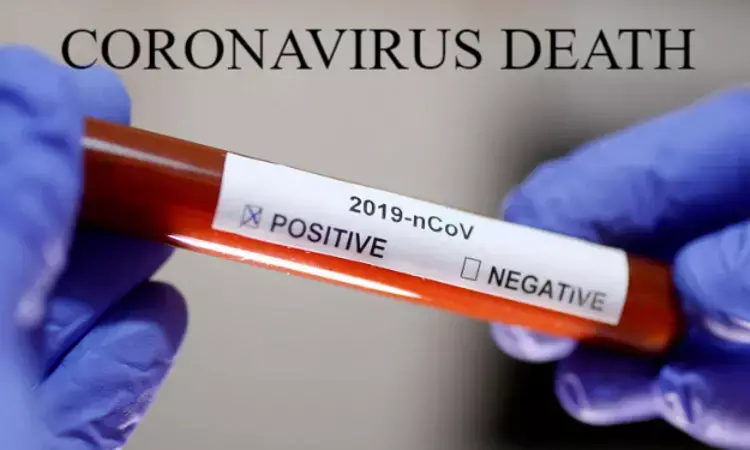- Home
- Medical news & Guidelines
- Anesthesiology
- Cardiology and CTVS
- Critical Care
- Dentistry
- Dermatology
- Diabetes and Endocrinology
- ENT
- Gastroenterology
- Medicine
- Nephrology
- Neurology
- Obstretics-Gynaecology
- Oncology
- Ophthalmology
- Orthopaedics
- Pediatrics-Neonatology
- Psychiatry
- Pulmonology
- Radiology
- Surgery
- Urology
- Laboratory Medicine
- Diet
- Nursing
- Paramedical
- Physiotherapy
- Health news
- Fact Check
- Bone Health Fact Check
- Brain Health Fact Check
- Cancer Related Fact Check
- Child Care Fact Check
- Dental and oral health fact check
- Diabetes and metabolic health fact check
- Diet and Nutrition Fact Check
- Eye and ENT Care Fact Check
- Fitness fact check
- Gut health fact check
- Heart health fact check
- Kidney health fact check
- Medical education fact check
- Men's health fact check
- Respiratory fact check
- Skin and hair care fact check
- Vaccine and Immunization fact check
- Women's health fact check
- AYUSH
- State News
- Andaman and Nicobar Islands
- Andhra Pradesh
- Arunachal Pradesh
- Assam
- Bihar
- Chandigarh
- Chattisgarh
- Dadra and Nagar Haveli
- Daman and Diu
- Delhi
- Goa
- Gujarat
- Haryana
- Himachal Pradesh
- Jammu & Kashmir
- Jharkhand
- Karnataka
- Kerala
- Ladakh
- Lakshadweep
- Madhya Pradesh
- Maharashtra
- Manipur
- Meghalaya
- Mizoram
- Nagaland
- Odisha
- Puducherry
- Punjab
- Rajasthan
- Sikkim
- Tamil Nadu
- Telangana
- Tripura
- Uttar Pradesh
- Uttrakhand
- West Bengal
- Medical Education
- Industry
Autopsy findings reveal thromboembolism as cause of death in Covid 19

The new Covid 19 pandemic has caused more than 2 lac deaths worldwide. However, little is known about the causes of death and the virus's pathologic features.
According to researchers a study of autopsy findings of the first 12 patients who died of COVID-19 in a hospital in Hamburg, Germany, has revealed that 7 (58%) of them had undiagnosed deep vein thrombosis, suggesting that the virus may cause abnormal blood clotting.In four cases, cause of death was massive pulmonary embolism with the thrombi originating in the deep veins of the lower limbs. Three additional cases had fresh deep venous thrombosis in both legs and no pulmonary embolism.
The study has been published in the Annals of Internal Medicine.
The researcher conducted a Prospective cohort study to validate and compare clinical findings with data from medical autopsy, virtual autopsy, and virologic tests.
Autopsies performed at a single academic medical center in first 12 consecutive COVID-19–positive deaths as mandated by the German federal state of Hamburg for patients dying with a polymerase chain reaction–confirmed diagnosis of COVID-19.
In the chosen patients complete autopsy, including postmortem computed tomography and histopathologic and virologic analysis, was performed. Along with this clinical data and medical course were also evaluated.
They detected highconcentrations of COVID-19 genetic material in the lungs, and also in the liver, kidney, or heart in five of six patients who had moderate viremia (COVID-19 viruses in the blood). All had abnormal lung computed tomography (CT) findings, and eight of them (67%) had alveolar damage indicative of early acute respiratory distress syndrome.
Further most lungs showed congested and were heavy, with a maximum combined weight of 3,420 grams in one patient. The mean combined lung weight was 1,988 grams (4.4 pounds). In comparison, standard lung weights for men are 840 grams (1.9 pounds) and 639 grams (1.4 pounds) for women. Only two patients had relatively low lung weights (550 and 890 grams).
In many cases, the lungs showed signs of mild pleurisy, inflammation of the thin layers of tissue that separate the lungs from the chest wall, as well as a patchy pattern consisting of pale areas contrasting with slightly protruding, firm, reddish-blue areas with high capillary-to-fiber ratios. The lungs were firm but crumbled easily.
In the 10 patients who died in the hospital, initial laboratory tests showed elevated levels of lactate dehydrogenase (indicating tissue damage), D-dimer (indicating blood clots), and C-reactive protein (indicating inflammation or heart damage), as well as mild thrombocytopenia (low levels of platelets needed for clotting) in 4 of 10 patients.
The authors concluded that "The high incidence of thromboembolic events suggests an important role of COVID-19-induced coagulopathy." Of note, many of these patients did not appear to have received chemoprophylaxis for thrombosis.
The doctors should always suspect pulmonary embolism in COVID-19 patients who have deteriorating heart and lung function. "That patients with COVID-19 who have increased D-dimer levels, a sign of coagulopathy, may benefit from anticoagulant treatment seems plausible," they wrote.
They called for further research into the molecular mechanism and clinical incidence of coronavirus-related death and possible treatment options such as the use of anti-clotting therapies for COVID-19 patients.
For further reference log on to:
DOI: 10.7326/M20-2003
Dr Kamal Kant Kohli-MBBS, DTCD- a chest specialist with more than 30 years of practice and a flair for writing clinical articles, Dr Kamal Kant Kohli joined Medical Dialogues as a Chief Editor of Medical News. Besides writing articles, as an editor, he proofreads and verifies all the medical content published on Medical Dialogues including those coming from journals, studies,medical conferences,guidelines etc. Email: drkohli@medicaldialogues.in. Contact no. 011-43720751


